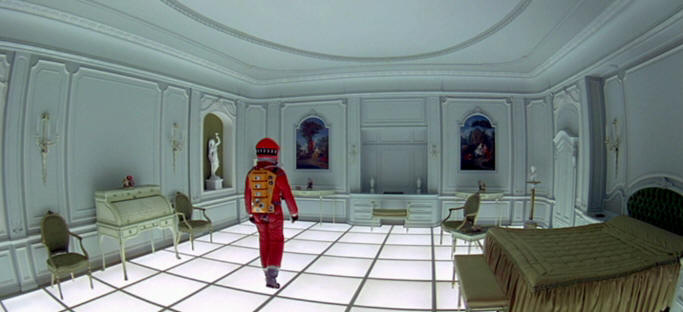

“Kubrick: and beyond the cinema frame”
An in-depth analysis of
2001: A SPACE ODYSSEY
Text copyright © by Rob Ager 2008
(last updates added 2015)
CHAPTER 6
KUBRICK AS GOD / MAN AS HIS OWN GOD
A simple progression of the monolith / cinema screen relationship is that, for the films characters, Kubrick effectively represents God. Because as film maker it is he who created the fictional universe as it is depicted in 2001. There are a variety of other production aspects implying this. A famous continuity error is that a crew member can be seen reflected in Heywood Floyd’s helmet as he walks around the monolith on the moon. It’s difficult to recognise who this person is, but it has been rumoured to be Stanley.


The close up has been contrast adjusted to emphasize the crew member reflection.
One of the production stills shows Poole sat in the Discovery cockpit with his helmet on, even though in the movie he isn't wearing one while sitting in the cockpit. Again a mysterious crew member is reflected in the side of the helmet. Is this a fluke or a confirmation that the helmet relfection of a crew member in the excavation site was deliberate?

An interesting production still from the excavation scene shows the astronauts stood in a semi-circle. Standing in the middle of them is Kubrick himself, dressed in black with the monolith seen left screen in front of a floodlight. A possible implication here is that the monolith is a representation of Kubrick and that he is appearing to the astronauts as the intellectual creative force of their universe.

A nice little pun on this idea is to think of the brick shaped monolith as a Stanley Ku”brick”. Notice also that the astronauts are wearing white lab coats, which will be explored in a later chapter.It was also an interesting choice of Kubrick to feature plenty of still shots of the excavation scene considering that the characters are actually conducting a photo shoot within the film.



Another production still offering similar God symbology hints is this one of Stanley in the artificial gravity section of the discovery.

Poole is sat staring at Stanley, who is leaning sideways as if saying “rotate me 90 degrees like you would the monolith” and again he’s dressed in black. The dimensions of the photo are also monolith shaped.As a further clue of the characters becoming their own Gods let's take a second look at the following production photos.

In the first shot Bowman is looking at the camera as if acknowledging us. Next he is turning as if about to sit down. Then in the third photo he is sat down, but Kubrick is now standing in the position he just walked from. It's as if he has just stepped out of himself and met his own director. The position Bowman was stood in during the first of the three photos is virtually the same position that he walked to in the film before a sudden jump cut to him entering the bathroom.

Something else interesting is that if Bowman does indeed become his own film director then this would also give him control of the film's musical score. Two production photos in particular seem to support this.


The actor Keir Dullea, who plays Bowman, is seen in character at a computer console in one shot and out of character playing a keyboard in the other shot. In both shots he is looking back over his right shoulder and both shots feature the same camera angle. Possibly related to this may be the mixed up and out of tune piano chords of the renaissance room, which are followed by an ensuing silence before Bowman's re-entry into the monolith and sudden repeat of the films opening theme. All this may well be communicating that having travelled outside the cinema frame and then back in, Bowman can now control the film content, including its musical score. He has become the director of the film he is in and therefore is his own God.The concept of Kubrick, Bowman or the viewer as a higher intellectual force is not necessarily an egotistic one. Stanley was a creative genius and no doubt he knew his own strengths, but with 2001 he seems hell bent on using his vast intellect to inspire us with intelligent design and paradigm shifting concepts. Just as the apes are fascinated by the monoliths geometrical perfection, which is completely alien to them, Stanley has presented us with a movie that is so intricate, original and multi-layered that we can only gasp in awe at the incredible power of his creative ability. He is mocking us. He is calling us intellectual primates. But he is also telling us that, like the apes, all we need to do is tilt our heads 90 degrees to notice the cinema screen connection. He is telling us that the human mind is capable of far more sophisticated output than most of us have ever suspected and he wants us to tap into that potential. The sophistication of 2001: A Space Odyssey proves his point.


